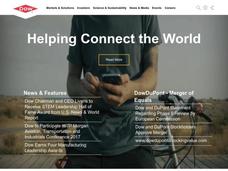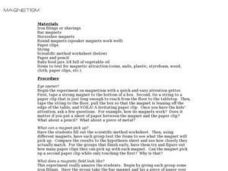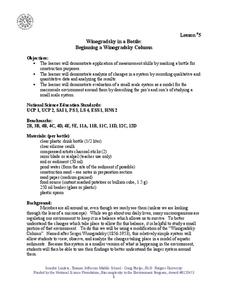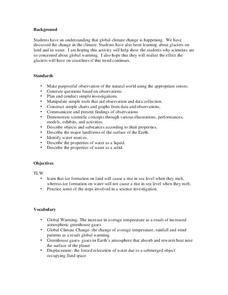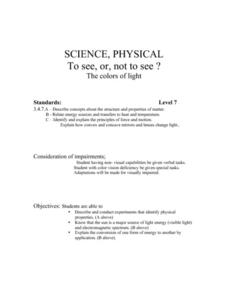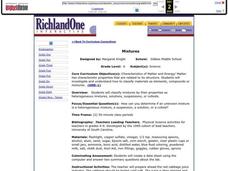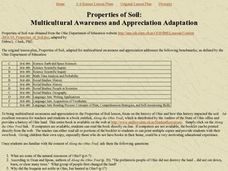Curated OER
Is There A Fungus Among Us?
Young scholars experiment with fungi and yeast in order to determine their role in nature. Students study terms associated with fungi and yeast through this series of lessons.
Curated OER
Magnetism and the Scientific method
Learners explore magnets and magnetic Fields. They experiment with various objects to determine which will be attracted to the magnet. Their results are recorded in a scientific method worksheet.
Curated OER
Shake, Rattle and Roll
Students compare the weathering of materials. in this weathering lesson, students experiment with the chemical and physical weathering of different materials. Students use salt and water as an example of how weathering occurs.
Curated OER
Three Clouds Activity
Learners explore how clouds are produced through three different age-appropriate hands-on experiments.
Curated OER
Smoothing Out the Rough Spots
Fifth graders experiment to observe the changes created on a surface by mechanical action of water with varying amounts of mineral content and abrasive qualities. They write the predictions of their outcomes and describe all of their...
Curated OER
Photosynthesis: Intake of Carbon Dioxide - Production of Oxygen
Students, after a long-term observation of photosynthesis with aquatic plants, assess the benefits of photosynthesis towards all living organisms. They explain in their own words the two cycles within photosynthesis. Guided discussion...
Curated OER
The Shape of Things
Students study the natural incubation of hens and the important characteristics of the egg shell. They perform experiments to test the strength of the dome shape of an egg and prove that an eggshell has pores to allow air to pass. ...
Curated OER
Radical Raptors
Students define raptor, explain why raptors are important, describe unique physical characteristics of various types of raptors, and explain life cycle of raptors. Students then play Habitat Game, describe food and hunting habits of...
Curated OER
Cats
Students participate in an after school program that promotes communication with others, solving problems, and making decisions. They experience getting in touch with themselves, about cats, training cats, showing cats and explore...
Curated OER
Chemical and Physical Changes
Students experiment, identify and apply the concepts of chemical and physical changes utilizing real-world examples. They discuss and model physical and chemical changes, answer guided questions and play a game that reinforces the...
Curated OER
The Investigation Of The Taste Buds
Students explore the sense of taste. In this biology lesson plan, students investigate the sense of tastes as they experience salty, sour, bitter, and sweet tastes. Students then discover how taste buds do their job.
Curated OER
Capillary Action Dip N' Dye
Students complete an experiment to observe capillary action. In this capillary action instructional activity, students add food coloring to a bowl and watch what happens as they dip the corner of the paper in it. Students observe...
Curated OER
Winogradsky in a Bottle: Beginning a Winogradsky Column
Students study changes in the environment using a microscale experiment. In this environmental science activity, students construct a modified "Winogradsky Column" to observe bacteria activities. They record observations and formulate a...
Curated OER
Global Climate Change
Second graders investigate the effect of melting glaciers to sea level. In this earth science lesson, 2nd graders simulate the process in the lab by conducting an experiment using ice cubes and clay. They explain the consequences of...
Curated OER
Mr. and Mrs. Cress Head
Students explore Earth science by completing a plant art project. In this botany instructional activity, students utilize tights and soil to create a furry, grassy puppet style animal from cress seeds. Students cut off the excess cress...
Curated OER
Sound Vibrations
Students examine how vibrations are responsible for the sounds we hear. Students experience vibrations using several of their senses.
Curated OER
SOUND VIBRATIONS
Student designs a test that uses their sense of hearing to judge the effectiveness of different solids to transmit sound vibrations. Students experience vibrations using several of their senses.
Curated OER
Matter
Third graders are introduced to the topic of matter. As a class, they brainstorm what they already know about matter and its properties. After completing a worksheet, they participate in an experiment in which they observe matter in...
Curated OER
To See or Not to See: The Colors of Light
Seventh graders describe and conduct an experiment that identifies the physical properties of light. They explore sources of visible light and an electromagnetic spectrum. Students explain the conversion of one form of energy to another.
Curated OER
Mixtures
Sixth graders experiment with mixtures. In this chemistry lesson, 6th graders determine which mixtures are considered heterogeneous, a suspension, a solution or a colloid. Students create a data sheet of what they discover.
Curated OER
Properties of Soil
Students encounter various pieces of knowledge utilizing lessons that addresses a diversity of learners with multiple intelligences. They cover various concepts: science, Earth, scientific inquiry, geometry, data analysis, probability,...
Curated OER
Sour Acids and Bitter Bases
Young scholars explore acids and bases. They experience the sour taste of acids and the bitter taste of bases by tasting substances such as chocolate, lemon juice, and baking soda. in addition, they complete a worksheet for individual...
Curated OER
Plate Tectonics
Students reinforce their knowledge of plate tectonics from what they have already learned on the subject. In this science lesson, students watch a small clip from the movie "Ice Age" which engages the students to participate throughout...
Curated OER
Wondrous Water
Students explore the different properties of water. They experimenting with different activities, each one explaining a different property of water. Students read an article "Small, Ues, But Might: The Molecule Called Water." and then...
